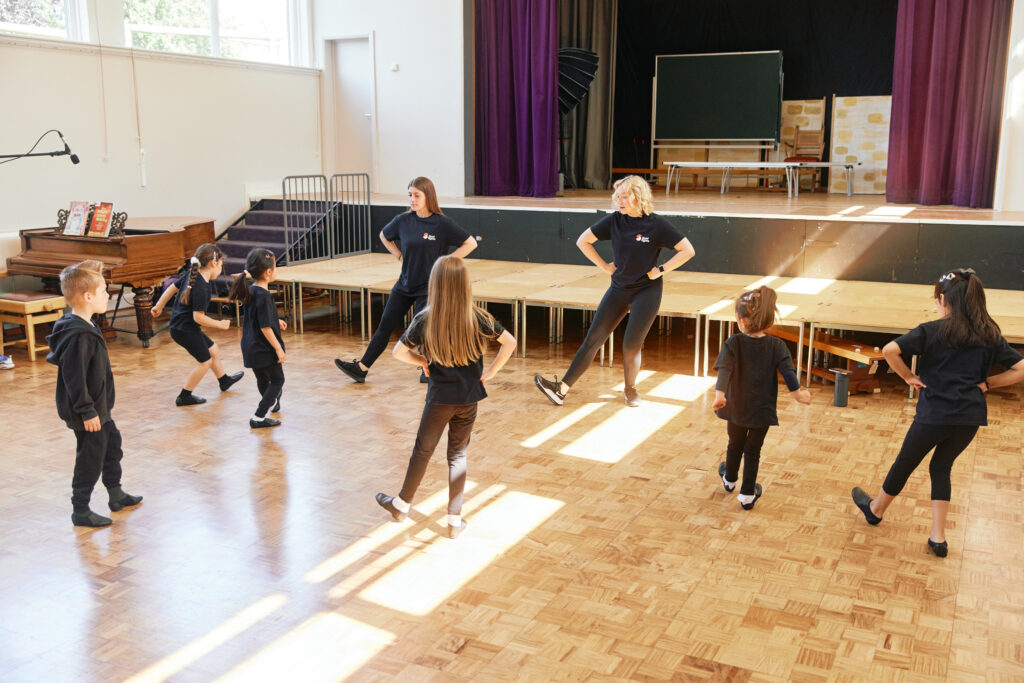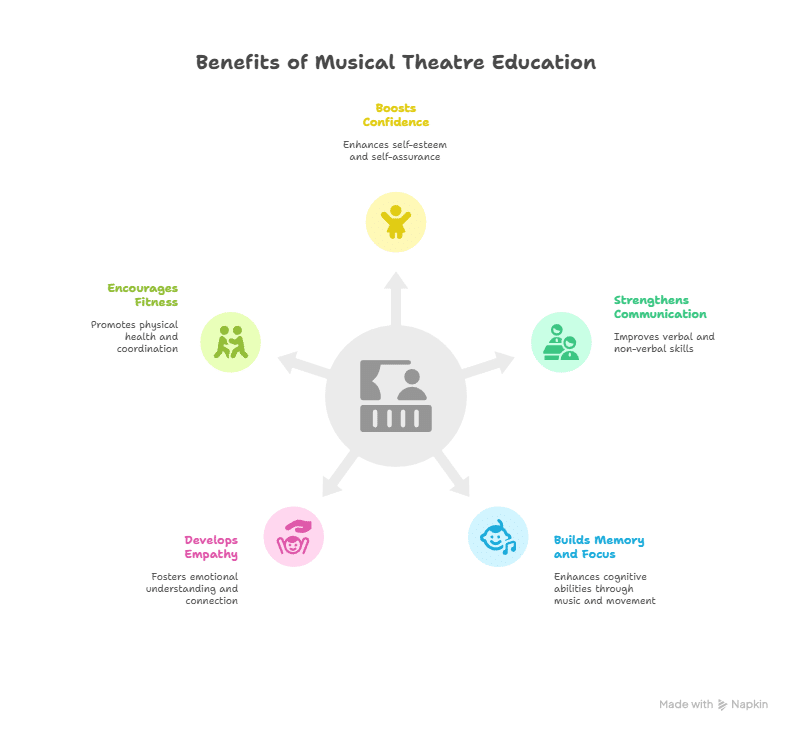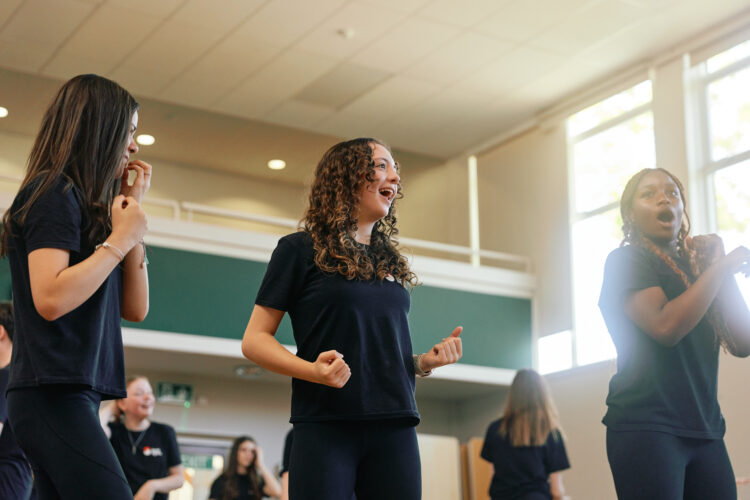
What Are the 4 Elements of Musical Theatre?
Musical theatre is a captivating performing art that combines songs, spoken dialogue, acting, and dance. The four key elements at the heart of every dramatic presentation. Unlike other forms found in the opera house or traditional plays, musical theatre weaves these components into vibrant storytelling, creating an umbrella term for a genre that entertains, educates, and inspires.
For children exploring modern musicals or interest in musical theatre classes, understanding these essential elements lays the foundation for growth in confidence, creativity, and social skills.
The Four Essential Elements of Musical Theatre: A Parent’s Guide to Understanding the Foundation of Musical Performance
Songs – The Heart of Musical Theatre Expression
Songs are a crucial element in musical theatre, serving as the main way characters express emotion, reveal their hopes, and advance the plot. Unlike simply singing, musical theatre combines songs with dramatic intention and movement, making each note an integral part of the story. Popular songs from shows like Matilda, Annie, and The Lion King use diverse musical styles, from lively ensemble numbers to heartfelt ballads.
Children develop vocal techniques through age-appropriate examples, learning not only pitch and breath control but also “acting through song,” which connects emotional content to lyrics. Under the guidance of industry-trained teachers, they explore classic and modern musicals, practising solos, group harmonies and even sung dialogue featured in shows such as West Side Story.
Understanding Different Types of Musical Theatre Songs
- Solo Numbers: “I Want” songs like “Part of Your World” let characters express desires.
- Ensemble Pieces: Group dynamics shine in numbers such as “It’s a Hard-Knock Life.”
- Dialogue Songs: Blend spoken and sung dialogue for story progression, seen in Les Misérables.
Vocal Techniques Essential for Young Performers
Fun breathing exercises, articulation drills, and practising safe vocal habits build a strong foundation for children to sing musical theatre better, helping them navigate different musical styles from classic West End musicals to uplifting modern musicals.
Children naturally move from songs to spoken dialogue, learning to tell a story in every form.
[Kids Musical Theatre Classes]
Spoken Dialogue – The Narrative Foundation
Spoken dialogue is the glue between musical numbers, advancing the plot and deepening character development. It’s a key element of musical theatre, occupying a significant portion of any show, sometimes up to 50%, and providing emotional content and story clarity that other elements cannot.
Children learn to interpret and deliver scripts, creating believable relationships and heightening dramatic moments between songs. For instance, in West Side Story and Miss Saigon, spoken sections transition seamlessly into elaborate songs, adding depth to every character and scene.
How Dialogue Connects Songs and Scenes
Effective dialogue bridges musical numbers and ensures continuity, as seen in Matilda, where witty exchanges and heartfelt spoken moments prepare the audience for the next song or dance number.
Dialogue, in turn, enables children to fully embrace their roles through acting.
Acting – Bringing Characters to Life
Acting and characterisation in drama is the transformative engine of musical theatre, turning performers into layered, relatable characters. Musical theatre involves both subtle and bold movements, with actors adopting elaborate costumes and dramatic presentations to bring the show’s emotional core to life.
Children aged 4–18 are introduced to role-play, improvisation, and script work tailored to their age. Engaging in simplified Stanislavski methods, they develop skills in emotional expression, stage presence, and character analysis, all essential when tackling classic musicals.
Age-Appropriate Acting Techniques
- Ages 4–7: Imaginative play and physical storytelling.
- Ages 8–12: Character analysis and group acting exercises.
- Teens: Complex character work and audition preparation.
Building Emotional Intelligence Through Character Work
By stepping into various roles, children nurture empathy and social awareness, a core reason why acting is a crucial element of musical theatre. These skills transfer beyond performance to real life.
Dance becomes the next step, enabling full-body emotional and artistic expression.
Dance – Movement as Storytelling
Dance enriches musical theatre by adding visual spectacle and supporting narrative momentum, think of iconic choreography in both classic and modern musicals. From jazz and ballet to contemporary and tap, each musical style plays a role in physical storytelling, often enhanced by elaborate costumes and synchronised stage movement.
Professional choreographers and dance instructors help children master coordination, fitness, rhythm and teamwork, which are just some of the many benefits of dance for young children. Whether recreating numbers from The Greatest Showman or inventing fresh moves for original productions, children discover the joy of combining music and movement as a unified art form.
Essential Dance Styles in Musical Theatre
- Jazz for energetic group routines.
- Ballet for elegance and technical grounding.
- Tap for rhythm and showmanship.
- Contemporary for expressive, emotional content.
Physical and Social Benefits
Dance improves cardiovascular health, flexibility, and fosters friendship through ensemble routines, a crucial element of every successful production.
By bringing together singing, dialogue, acting, and dance, children experience the magic of integrated musical theatre.
See Also: How To Find Kids Dance Classes in London

How the Elements Work Together in Performance
| Element | Primary Function | Skills Developed | Age to Start |
| Songs | Emotional expression, story advancement | Vocal technique, musicality, breath control | Age 4+ |
| Dialogue | Character development, plot progression | Communication, script analysis, improvisation | Age 4+ |
| Acting | Character portrayal, believability | Emotional intelligence, confidence, creativity | Age 4+ |
| Dance | Visual storytelling, physical expression | Coordination, fitness, rhythm, teamwork | Age 4+ |
Benefits of Musical Theatre Education for Children
Musical theatre provides benefits well beyond the stage:
- Boosts confidence, creativity, and self-expression
- Strengthens communication and social teamwork
- Builds memory, focus, and academic ability through music and movement
- Develops empathy and emotional intelligence through dramatic presentations and character work
- Encourages fitness and discipline with group dance and coordinated routines
Research shows that children involved in performing arts outperform peers in academic and social areas, benefiting from skills that support lifelong learning and adaptability, far beyond other forms of extracurricular activity.

Choosing Musical Theatre Classes for Your Child
Seek welcoming, professional classes run by industry-trained teachers, with age-appropriate programs grouped for ages 4–6, 7–11, and 12–18. Look for a supportive environment where children can try out various key elements of musical theatre, from singing popular songs in class to full-scale performances with costumes at the end of term.
The right theatre school guides children through vocal, acting, and dance training, provides clear progression, and celebrates every student’s journey, whether they dream of the West End stage or simply want to enjoy music, movement, and friendship.
Popular Musicals for Children to Learn and Perform
Here are a few example of musicals with kids in them:
- For ages 4–8: Lion King Jr., Annie Kids, and Aladdin Jr.—each with accessible stories and music.
- For older children and teens: Matilda, High School Musical and Oliver! challenge creativity and technique while remaining age-appropriate.
Selecting shows that reflect diverse musical styles and emotional content keeps children engaged and motivated.
Looking for Musical Theatre for Kids in London?
Musical theatre’s four key elements: songs, dialogue, acting, and dance form a creative, comprehensive educational experience for children. By enrolling your child in quality programmes, you support growth in communication, confidence, and creativity.
If your child has the theatre bug, why not help them take centre stage? At Spotlights, our range of weekly classes and holiday workshops cater to children of all ages and skill levels, making it an inclusive and nurturing environment for all.
Book your free trial or get in touch for more information!
FAQs
What are the four elements of musical theatre, and why are they important?
The four elements: songs, spoken dialogue, acting, and dance are each a crucial component of musical theatre. They work together to tell a complete story, allowing characters to express emotion, advance the plot, build believable personalities, and add visual excitement to every performance.
How do the four elements interact in a typical musical?
In most musicals, these elements are woven together: songs express characters’ feelings and move the story forward, dialogue connects musical numbers and builds relationships, acting brings each role to life, and dance adds energy and helps narrate the story visually. Their integration is what sets musical theatre apart from other forms of performance.
Can children benefit from learning all four elements, even if they prefer one more than the others?
Yes, exploring all four elements helps children build a balanced skillset. For example, a child who loves singing will improve expression and stage presence through acting and dance, while a child attracted to movement will gain confidence and communication skills from dialogue and song. This well-rounded approach encourages personal growth and teamwork.
Which Class Is Best For My Child?
We have a range of classes available for children ages 4-18 years. Find out more about each of our groups to see which classes are best for your child.
Little Stars Performing Arts Class – These weekly classes are for children aged 4-7. They include acting, singing and dancing classes to introduce children to the fun of performing arts.
Stars 1, 2 & 3 Classes – These are our weekly acting, singing and dancing classes. Stars groups are for children aged 7-18. Children are split into school years so your children learn with similar aged children.
Lamda Classes – Our LAMDA classes are weekly classes offered to existing Spotlights children aged 7+. These are additional group drama examinations.
Weekend Drama Classes – Our weekend performing arts classes for children are a blend of fun, creativity, and skill-building, designed for children aged 4-18.
Holiday Camp Drama Classes – Our holiday classes are week long courses with a mix of acting, singing and dancing. They are for all ages and are based around a theme such as Disney, Greatest Showman and more. At the end of the course we put on a costumed performance to the children’s family and friends.
Spotlights Performing Arts Classes
We have a range of dance, drama and singing classes for children ages 4-18 years.
Find the best performing arts class for your child!




